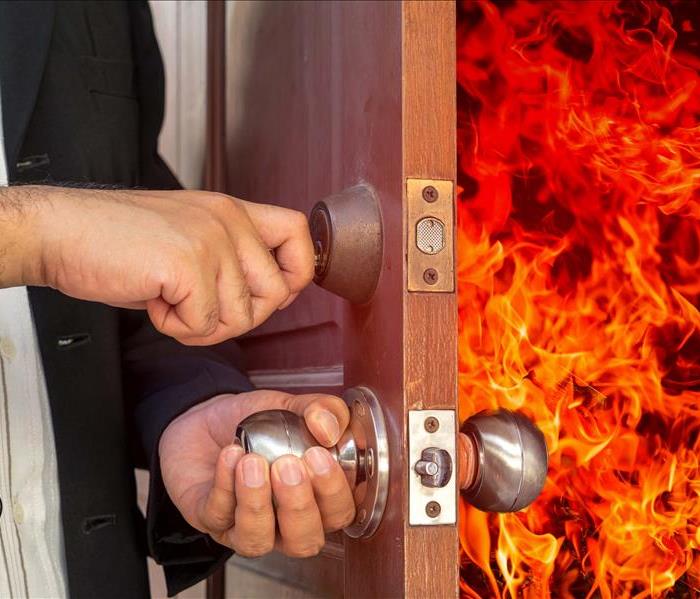Most Common Areas in Your Home for a Fire to Start
5/15/2019 (Permalink)
Places and Items Prone to Smoke and Fire Damage
It's important to identify areas, objects and circumstances that are more likely to be fire hazards than others, to help prevent any home fires and keep your house up-to-date on safety practices. Keep fire extinguishers in the kitchen, garage, and near any appliances that use heat/electricity. It's also a good idea (if not required by code) to have smoke detectors in every room of the house – especially bedrooms – and to check them at least once a month to make sure the devices are working properly.
1. KITCHEN
It's crucial to practice home fire safety in the kitchen because it's the place where most home fires originate. In fact, half of all residential fires start in the kitchen due to appliances that utilize heat/electricity, cooking-related incidents (such as an unattended oven/stovetop), or fabric and material (a dishcloth, for example) that's too close to heat. A dirty oven/stovetop that has a lot of baked-on grease and residue is another fire safety hazard, as it can easily cause grease fires.
2. APPLIANCES
Most homes have a number of appliances, many of which operate with electricity, gas or heat (or some combination of these) and can be potential fire hazards. Older appliances (15 years or older) are particularly prone to fire damage especially if they aren't regularly cleaned/inspected and properly maintained. It's a good idea to only run appliances when you're at home to avoid having to deal with any safety issues or fire restoration, in the unexpected case that they overheat and/or ignite.
- Dryers – Lint, fiber and dust buildup in dryers is one of the main causes of a laundry room fire. Make sure to keep vents and filters clean by removing any lint after each use and to clean out the lint from the hose connected to the back of the dryer at least once a year.
- Dishwashers – Heating elements in the dishwasher raise the water temperature and help dry the dishes. These mechanisms can overheat and catch fire, especially in older models or if the dishwasher has faulty parts.
- Microwaves – Although they are convenient, microwaves can be dangerous if you heat food or materials (such as aluminum foil, Styrofoam or certain plastic containers) that are flammable. You could end up with a fire or even smoke damage if not quickly extinguished.
- Toasters/Toaster Ovens – The electrical elements inside a toaster can start to become faulty over time and may not turn off, which could start a fire. Crumbs can accumulate and become stuck at the bottom of the toaster, so make sure to clean it regularly to prevent a fire and never leave these appliances unsupervised when in use.
3. BEDROOM
There are many potential fire hazards in bedrooms – bedding, curtains, plush items, mattresses – which make this room a high risk for fire damage. Mattresses made after 2007 are flame-retardant and comply with higher safety standards. Most mattresses made before 2007 usually aren't up to code with the Federal Mattress Flammability Standard, so you may want to consider upgrading to a new one. Incorporate home fire safety by installing smoke alarms in each bedroom and make a fire escape plan that includes two ways to exit the room (usually through the door and a window).
4. CHIMNEYS AND FIREPLACES
Some common issues that arise with chimneys and fireplaces include structural problems which can cause temperatures to burn too high, or chimney liners that are loose or have become detached which can cause burning embers and ash to escape to combustible areas in walls, attics and roofs. Keep chimneys and fireplaces cleaned and maintained. You should have them inspected and professionally cleaned at least once a year or when there is a quarter-inch buildup of creosote or soot. Rugs, tapestries and other fabrics that are too close to the fireplace can easily ignite. Prevent this by keeping cloth items away from the fireplace and always keep a spark screen in front of the fireplace.
5. LIVING ROOM
Like bedrooms, living rooms contain many potentially flammable items – electronics, drapes/curtains, furniture – which could easily catch fire and spread it rapidly. One of the leading fire hazards in living rooms are candles. Never leave a burning candle unattended and make sure it’s kept away from flammable/combustible objects.
Fire Cleanup
You may be able to handle some of the fire cleanup on your own, such as ventilating your home by opening all of the windows and washing all of your clothes and fabric items that have been exposed to fire and smoke damage. However, for cleanup and fire damage restoration tasks, it's advisable to hire a professional fire restoration company.
Call us for 24/7 Emergency Response to your Fire Damage Restoration needs.

 24/7 Emergency Service
24/7 Emergency Service
